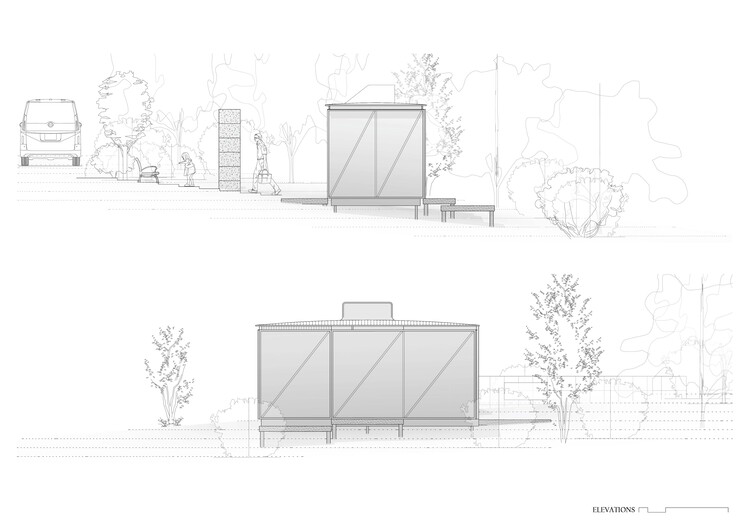
-
Architects: Green Studio
- Area: 15 m²
- Year: 2024
-
Photographs:Callan Green
-
Lead Architect: Callan Green

Text description provided by the architects. At the beginning of the Great Alpine Road in rolling foothills and eucalyptus forest, the client wanted a small temporary dwelling to highlight the natural features of the landscape and to eventually leave the site free without any residual impact of settlement. The forested landscape home to a thriving ecosystem, also has an uncanny collection of lone chimneys, their dwellings have disappeared without a trace by way of wildfire or economic shifts in time, this landscape understands the concept of impermanence.

A discarded shipping container provides the transportable structure, delivered by truck to the site. An inventory of salvaged materials sets the design constraints, designing with what we have currently. The challenge was to fit all the necessities of daily life into this small 15sqm footprint: kitchen, living, dining, bathroom, bedroom, and storage. In the Australian context, there is traditionally an in-between place where greetings happen, boots are kicked off, rolling storms pass by, informal meals take place, and all other ranges of activities take place under protection from the elements. House on Hill employs lift-assisted operable verandah awnings constructed of steel angle and polycarbonate, opening upwards and outwards when occupied and retracting when not in use or in transport.




The pavilion responds to the harsh climatic conditions and landscape vernacular with a hard-shell metal-clad exterior. A rectangular form of simple corrugated sheet is outlined by galvanized steel angles that also support the windows, doors, and awnings. On the south elevation an oversized steel lintel supports a large sliding glass panel on concealed rollers, the glass panel fully retracts against a flat metal sheet section of the wall to connect the elevated decking area. To the East façade, existing weather-sealed steel container doors remain, including their embodied carbon and structural integrity. Semi-opaque cladding and full operability allow the bathroom to extend outwards into a dense natural environment.


Green Studio acts as the Architect and the Master craftsman, fashioning and assembling an array of gathered materials in a holistic manner, as opposed to a systematic specification process. A solid timber front door custom-made to house a dynamic lead-light window crafted by Hygge Glass, its design hinting to the warmth beyond with themes of the surrounding landscape. Stepping inside, reclaimed Victorian Ash Glulam beams interlock to form an entry nook and extensive library shelving. Tactile and acoustic cork wall tiles define an intimate sitting area and bedroom section.



A custom-built table fits three chairs snugly inside when not in use, sliding the table out forms a simple study desk, and turning 90 degrees to the generous bench seat forms a dining table arrangement with the three chairs. The table and chairs, made in Green Studio's timber workshop employ a classic finger-join technique common to Australian-made furniture of the type. Flexible living with innovative functionality not only makes possible the small footprint building but increases real estate 'value' from an occupant's sense.

100-plus-year-old kauri pine carefully removed from a nearby decommissioned dance hall has been tediously prepared to line internal walls and ceiling. Undulations are clearly visible from the decades of dancing shoes slowly wearing away at the fragrant soft timber.
Green Studio has crafted a range of goods and wares for use in House on Hill, from timber serving plates, serving utensils, key bowls, incense burners, bookends, stools, handles, etc. Each piece contributes to the experience of dwelling in diverse a landscape. A sliding timber screen separates a compact wet area characterized by a recessive mood of calm and shadow. Black form ply, grey granite, and corrugated sheet, all reclaimed of course, open outwards via the massive semi-opaque doors. The small space now turns into an expansive retreat.

In the previous life of the metal container (now turned house structure) it would receive grain through a circular opening in its roof. Through construction, it was noticed the circular shadow lifted its rigid rectangular form as it moved throughout the internal space – a skylight now continues to provide this joyful experience. This project has been a journey of resourcefulness, an arm of self-sufficiency. A way of designing and building with what one has rather than what one can take.























